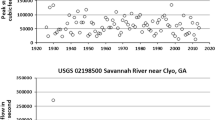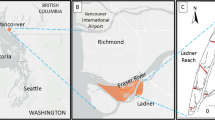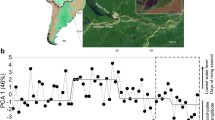Abstract
Temporal changes in vegetation patterns of Chesapeake Bay wetlands have been poorly documented. Data from a 1987 vegetation analysis of a Chesapeake Bay tidal freshwater marsh were compared to those of a vegetation study completed in 1974. Changes in the vegetation pattern were calculated using species importance values and a species diversity index. Comparison of the 1987 and 1974 results shows no significant difference in species diversity index. However, there was a significant difference in species contribution to the index.Spartina cynosuroides, an oligohaline species that was not among the dominant species listed in the 1974 study, had the fourth highest importance value in this study. The change in dominant species composition of the marsh may reflect a directional shift from tidal freshwater toward oligohaline conditions.
Similar content being viewed by others
Literature Cited
Anderson, R. R., R. G. Brown, and R. D. Rappleye. 1968. Water quality and plant distribution along the upper Patuxent River, Maryland. Chesapeake Science 9:145–156.
Atkinson, R. B., N. L. Bodkin, and J. E. Perry. 1990. New county records collected in tidal wetlands of four Coastal Plain counties along the James River, Virginia. Castanea 55:56–64.
Bradshaw, J. G. and A. Y. Kuo. 1987. Salinity distribution in the James River estuary. School of Marine Science, Virginia Institute of Marine Science College of William and Mary, Gloucester Point, VA, USA. SR 292.
Brinson, M. M. 1993. Changes in the functioning of wetlands along environmental gradients. Wetlands 13:65–74.
Brooks, T. J. 1983. Pamunkey River slack water data report: temperature, salinity, dissolved oxygen. 1970–1980. School of Marine Science, Virginia Institute of Marine Science, College of William and Mary, Gloucester Point, VA, USA. VIMS Data Report #20.
Curtis, J. T. and R. P. McIntosh. 1950. The interrelations of certain analytical and synthetic phytosociological characters. Ecology 31:434–455.
DataMost. 1994. StatMost for Windows Statistical Analysis and Graphics. v. 2.01. DataMost, Salt Lake City, UT, USA.
Daubenmire, R. 1966. Vegetation: identification of typal communities. Science 151:291–298.
Daubenmire, R. 1968. Plant Communities: a Textbook on Plant Synecology. Harper and Rowe, New York, NY, USA.
Doumlele, D. G. 1976. Primary production and plant community structure in a tidal freshwater marsh. M.A. Thesis School of Marine Science, Virginia Institute of Marine Science, College of William and Mary, Gloucester Point, VA, USA.
Doumlele, D. G. 1981. Primary production and seasonal aspects of emergent plants in a tidal freshwater marsh. Estuaries 4:139–142.
Froomer, N. L. 1980. Sea level changes in the Chesapeake Bay during historic times. Marine Geology 36:289–305.
Gleason, H. A. and A. Cronquist. 1991. Manual of Vascular Plants of Northeastern United States and Adiacent Canada. Second Edition. New York Botanical Garden. Bronx: NY, USA.
Gosselink, J. G. and R. E. Turner. 1978. The role of hydrology in freshwater wetland ecosystems. p. 63–78.In R. E. Good, D. F. Whigham and R. L. Simpson (eds.) Freshwater Wetlands: Ecological Processes and Management Potential Academic Press. New York, NY, USA.
Hackney, C. T., S. Brady, L. Stemmy, M. Boris, C. Dennis, T. Hancock, M. O’Bryon, C. Tilton, and E. Barbee. 1996. Does intertidal vegetation indicate specific soil and hydrologic conditions. Wetlands 16:89–94.
Hicks, S. D. 1972. On the classification and trends of long period sea level series. Shore and Beach 40:20–23.
Holdahl, S. A. and N. L. Morrison. 1974. Regional investigations of vertical crustal movements in the U.S., using precise relevelings and mareographic data. Tectophysics 23:373–390.
Hull, C. H. J. and J. G. Titus (eds.). 1986. Greenhouse effect, sea level rise and salinity in the Delaware Estuary. U.S. Environmental Protection Agency and Delaware River Basin Commission, Washington, DC. USA.
Kadlec, J. A. 1962. Effects of a drawdown on a waterfowl impoundment. Ecology 43:267–281.
Knauss, J. A. 1978. Introduction to Physical Oceanography. Prentice-Hall, Inc. Englewood Cliffs, NJ, USA.
Kontkanen, P. 1957. On the delincation of communities on research on animal biocoenotics. Cold Springs Harbor Symposium of Quantitative Biology 22:373–378.
Mueller-Dombois, D. and H. Ellenberg. 1974. Arms and Methods of Vegetation Ecology. John Wiley & Sons, Inc., New York, NY, USA.
National Weather Service. 1996, Regional Climatic Data for Virginia. Wakefield, VA, USA.
Odum, W. E. 1988. Comparative ecology of tidal freshwater and salt marshes. Annual Review Ecological Systematics 19:147–76.
Odum, W. E., T. J. Smith III, J. K. Hoover, and C. C. McIvor. 1984. The ecology of tidal freshwater marshes of the United States east coast: a community profile U.S. Fish and Wildlife Service. Office of Biological Services, Washington, DC, USA. FWS/OBS-83/17.
Perry, J. E. and R. B. Atkinson. 1997. Plant diversity along a salinity gradient of four marshes on the York and Pamunkey Rivers in Virginia. Castanea 62(2):112–118.
Phillip, C. C. and R. G. Brown. 1965. Ecological studies of the transition-zone vascular plants in South River, Maryland. Chesapeake Science 6:73–81.
Phillips, E. A. 1959. Methods of Vegetation Study. Holt, Rinchart and Winston, New York, +NY, USA.
Pielou, E. C. 1969. An Introduction to Mathematical Ecology. John Wiley & Sons, New York, NY, USA.
Radford, A. E., H. E. Ahles, and R. E. Bell. 1968. Manual of the Vascular Flora of the Carolinas. University North Carolina Press, Charlotte, NC, USA.
Silbernorn, G. M. 1982. Common Plants of the Mid-Atlantic Coast: a Field Guide. John Hopkins University Press, Baltimore, MD, USA.
Shannon, C. E. and W. Weaver. 1949. The Mathematical Theory of Communication. University of Illinois Press, Urpana, IL, USA.
Titus, J. G (ed.) 1987. Greenhouse effect, sea level rise and coastal wetlands. U.S. Environmental Protection Agency, Office of Planning and Evaluation, Washington, DC, USA.
U.S. Department of Commerce. 1991. Tide Tables 1992: high and low water predictions-East Coast of North and South America including Greenland. U.S. Department of Commerce, National Oceanic and Atmospheric Administration. National Ocean Service, Washington, DC, USA.
van der Valk, A. G. 1978. The role of seed banks in the vegetation dynamics of prairie glacial marshes. Ecology 59:322–335.
van der Valk, A. G. 1981. Succession in wetlands: a Gleasonian Ecology 62:688–696.
van der Valk, A. G. and C. B. Davis. 1976. Changes in composition, structure, and production of plant communities along a perturbed wetland coenocline. Vegetatio 32:87–96.
Warren, R. S. and W. A. Niering. 1993. Vegetation change on a northeast tidal marsh: interactions of sea level rise and marsh accretion. Ecology 74:76–103.
Wass, M. L. and T. D. Wright. 1969. Coastal wetlands of Virginia Institute of Marine Science, College of William and Mary, Gloucester Point, VA, USA Special Report in Applied Marine Science and Ocean Engineering, Number 10.
Author information
Authors and Affiliations
Rights and permissions
About this article
Cite this article
Perry, J.E., Hershner, C.H. Temporal changes in the vegetation pattern in a tidal freshwater marsh. Wetlands 19, 90–99 (1999). https://doi.org/10.1007/BF03161737
Received:
Revised:
Accepted:
Issue Date:
DOI: https://doi.org/10.1007/BF03161737




